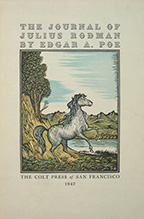Unfinished faux Lewis & Clark-ish expedition
 Edgar Allan Poe is most famous for his horror and mystery writing, but he also dabbled in adventure literature, most notably with his 1838 novel The Narrative of Arthur Gordon Pym of Nantucket, about an Antarctic expedition. Another foray into this genre, The Journal of Julius Rodman, was serialized in 1840 issues of Burton’s Gentleman’s Magazine. Only six chapters of this novel ever saw publication. After that, Poe had a disagreement with the editor William Burton and refused to finish the work, so these six chapters are all that remain of what would have been Poe’s second novel.
Edgar Allan Poe is most famous for his horror and mystery writing, but he also dabbled in adventure literature, most notably with his 1838 novel The Narrative of Arthur Gordon Pym of Nantucket, about an Antarctic expedition. Another foray into this genre, The Journal of Julius Rodman, was serialized in 1840 issues of Burton’s Gentleman’s Magazine. Only six chapters of this novel ever saw publication. After that, Poe had a disagreement with the editor William Burton and refused to finish the work, so these six chapters are all that remain of what would have been Poe’s second novel.Had the novel been completed, the fictional Julius Rodman would have been the first white man to cross the Rocky Mountains and reach the Pacific Ocean. The Journal of Julius Rodman is ostensibly the recently discovered memoir of this pioneering explorer. Most of the narrative is told in the first person by Rodman, but the text also contains extensive passages of third-person commentary by an anonymous editor. In the introductory chapter, this editor gives a historical overview of North American exploration, explaining that Alexander Mackenzie crossed the continent in 1793, Lewis and Clark reached the Pacific Ocean in 1805, but Julius Rodman beat them both by crossing the Rockies in 1792.
Accounts of the Lewis and Clark expedition were published in the early 19th century, and it is clear that Poe read them. The journals of Lewis and Clark are not high in literary merit but are valuable for their wealth of empirical observation. The prose is often dry but rigidly factual: “We stopped here. This is what the topography was like. The rapids were difficult. We shot such-and-such an animal and ate it. We met some Indians or a bear.” If anything, one would hope that for this sort of project Poe would apply his prodigious literary talents to crafting a more exciting and more literarily satisfying narrative. Instead, Poe writes Rodman’s journal in the same empirical style as the Lewis and Clark account, relating a series of stops along the river and what was seen there. There is no interpersonal drama between the members of the expedition, as one might find in a Jules Verne adventure. Rodman exhibits no personal growth through his battles with nature as one finds in a book like Daniel Defoe’s Robinson Crusoe. No spiritual or supernatural occurrences take place in the wilderness, like those Poe injected into The Narrative of Arthur Gordon Pym. Poe’s intention here is to write a false but believable expedition narrative, and in fact some members of Congress who read The Journal of Julius Rodman believed the faux explorer to be real. The lack of artistic license, however, makes for a dull and unsatisfying novel.
What’s worse, at times Poe steals too blatantly from the Lewis and Clark story. The dog on the Rodman expedition is suspiciously similar to Meriwether Lewis’s dog Seaman, both being of the Newfoundland breed. Rodman’s expedition also includes a black slave named Toby, and Poe includes a scene lifted straight from the life of William Clark’s slave York, in which Native Americans respond with amazement at their first sight of a black man.
The final chapter of this incomplete novel concludes with an exciting adventure scene that shows some promise of what might have been had Poe continued with the narrative. As it stands, however, this is not among Poe’s best work. Why read Poe’s descriptions of places he’s never seen when you can read the accounts of real explorers (Lewis and Clark, Mackenzie, Zebulon Pike, Stephen H. Long, the Astoria expedition) who actually made perilous journeys into the American West?
If you liked this review, please follow the link below to Amazon.com and give me a “helpful” vote. Thank you.
https://www.amazon.com/review/R211W0CM94USUW/ref=cm_cr_srp_d_rdp_perm


No comments:
Post a Comment